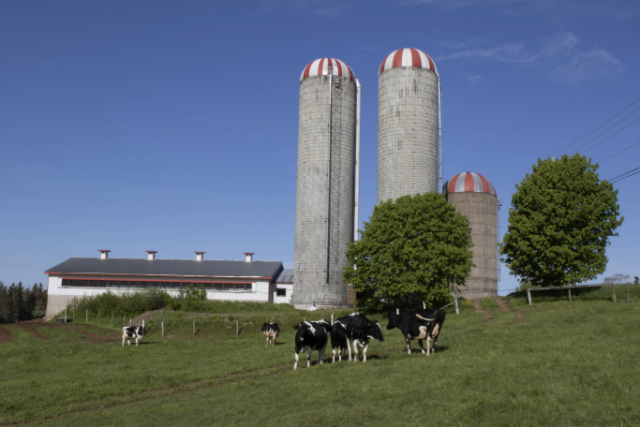As the world’s population grows, demand for animal products is expected to rise as well. Developing countries are projected to have the biggest growth in demand for animal-based proteins, as their incomes begin to rise and urbanization intensifies. These projections form the basis of Dr. Kim Ominski’s webinar, “The role of livestock in sustainable food production systems in Canada,” presented on June 11 for the Animal Nutrition Conference of Canada, held by the Animal Nutrition Association of Canada. Ominski uses these projections as motivation to understand the role of animal-based proteins in the diets of Canadians and how production emissions for them can be determined.
As many people are aware, consumers have preferences which vary by individual and country and determine the food they consume. Some of these preferences include environmental sustainability of food, nutritional value, animal welfare, and food safety as it relates to the use of antibiotics, hormones and pathogens. Over time, these preferences may change.
Canada has seen increased consumption of chicken over the past decade, while consumption of beef, pork and fluid milk have fallen. The implications on animal production systems in Canada are obvious; however, understanding the reasons behind these changes is complicated.
Consumers are largely informed about livestock production systems through different media outlets, including social media. These outlets tend to portray animal production systems in a negative light and often glaze over the positive issues, even when an abundance of resources on the topic exist.
Ominski drew from the Food and Agriculture Organization of the United Nations’ definition of a sustainable diet, which explains the concept as “diets with low environmental impacts, which contribute to food and nutritional security and to a healthy life for present and future generations.” This concept has become increasingly important, and Ominski made this clear when she said, “In the last decade, we’ve seen the link between diet, health and the environment.” She added, “This has increased the complexity of diet selection for consumers.”
Much of the current discussion on how to have a more sustainable diet criticizes animal agriculture in favour of plant-based diets to improve sustainability, decrease greenhouse gas emissions and land use, and improve human health. Referencing a study done in the U.S. that analyzed a food system that eliminated animal agriculture, Ominski challenged the validity of these discussions. The study, Ominski cited, found that animal-derived food products provide close to a quarter of energy and nearly half of all protein for human consumption in the U.S.
The same study found that diets formulated in a plants-only system reduced greenhouse gas emissions by 2.6% on a national basis. Thus, Ominski argued that while food options are important, more options make it more difficult for consumers to understand the implications of their food choices.
Ominski stated, “An environmental footprint is really the evaluation of sustainability of [food] products.” This footprint should look at factors such as greenhouse gas emissions, nutrient cycling, water use and quality, air quality, carbon storage and biodiversity. Many of these factors can be difficult to measure.
To better evaluate an environmental footprint, Ominski relies in part on life cycle assessments. These are assessments that have differing boundaries but look at the inputs of a production system and its environmental outputs. Ominski said, “This notion of outputs is important in terms of our discussions of how we interpret these environmental footprints.”
Functional units are used to express the environmental footprint of a livestock system. They can be expressed in multiple ways. These methods include net emissions, emissions made per unit of commodity or emissions per unit of nutrient produced. Depending on the functional unit and how it is expressed, it can significantly impact the outlook of studies. For example, some studies have found that on a per-unit basis, fruits and vegetables have the lowest emissions of any food source. When looking at the same studies on a per-nutrient basis, fruits and vegetables are found to have the highest emissions of any food source.
In Canada, 8.1% of greenhouse gas emissions are caused by the agriculture sector. Ominski argued this is not a very large portion of the emissions and that productivity increases in agriculture have meant that emission intensity has gone down. Looking at several studies, the environmental footprint of beef production in Canada has improved since 1981. The industry was found to use less land and create a smaller carbon footprint. Although ammonia emissions and water use have gone up in the beef sector, Ominski argued this is not necessarily a bad thing as the intensity of both have gone down on a per-unit basis.
In the dairy sector, fat- and protein-corrected milk production increased 43% between 1991 and 2011. Despite this increase, methane and greenhouse gas emission intensity associated with this production has decreased by 22%.
Ominski explained many of these improvements are related to improved animal performance, as well as improved crop yields and irrigation efficiency. Thus, she said, as production efficiency increases, emission intensity decreases.
One way to consider emissions from livestock production systems is to examine them through the lens of a circular economy. This means to consider all the products and byproducts made as a result of raising animals. This might include things like manure, the use of materials insufficient for human consumption to become food, as well as any animal-based products that are used for industrial purposes. “It’s very difficult to come up with a total systems sustainability assessment because these systems are quite complex,” Ominski said.
The difficulty presented in determining the true sustainability of livestock production systems in Canada makes it even more difficult to connect with consumers and share valuable information. Ominski acknowledged the need for better strategies to engage with consumers and offered a few tips. She encouraged producers and others in the livestock industry to have a dialogue with consumers and to avoid one-sided conversations. She noted there is no “silver-bullet approach,” and multi-stakeholder collaboration is important to engaging with consumers. As demand for animal-based protein changes, it is imperative to help people make informed decisions.









